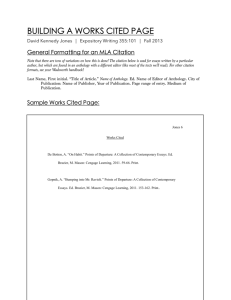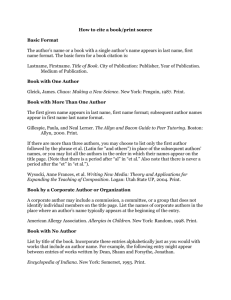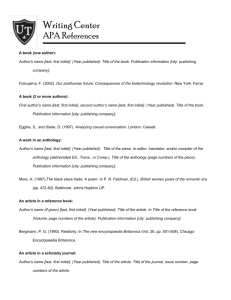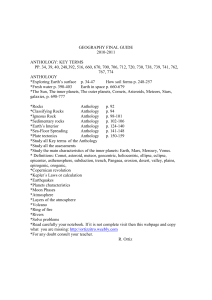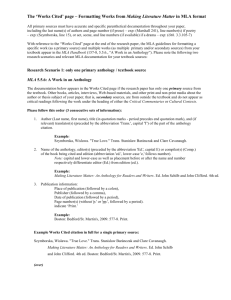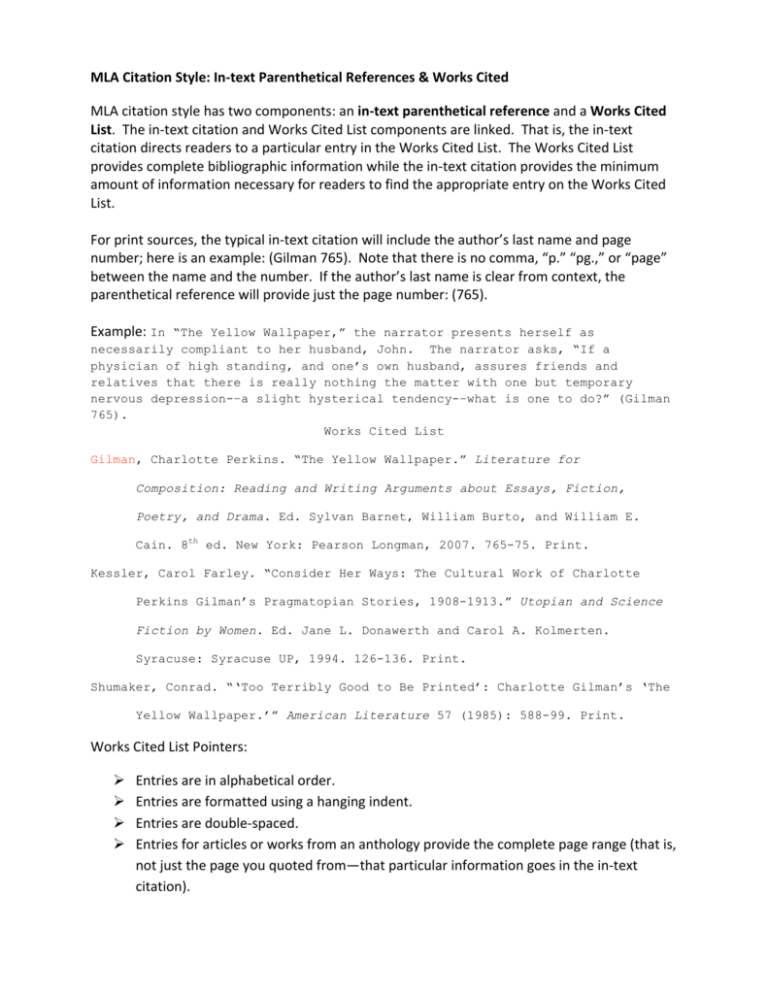
MLA
Citation
Style:
In‐text
Parenthetical
References
&
Works
Cited
MLA
citation
style
has
two
components:
an
in‐text
parenthetical
reference
and
a
Works
Cited
List.
The
in‐text
citation
and
Works
Cited
List
components
are
linked.
That
is,
the
in‐text
citation
directs
readers
to
a
particular
entry
in
the
Works
Cited
List.
The
Works
Cited
List
provides
complete
bibliographic
information
while
the
in‐text
citation
provides
the
minimum
amount
of
information
necessary
for
readers
to
find
the
appropriate
entry
on
the
Works
Cited
List.
For
print
sources,
the
typical
in‐text
citation
will
include
the
author’s
last
name
and
page
number;
here
is
an
example:
(Gilman
765).
Note
that
there
is
no
comma,
“p.”
“pg.,”
or
“page”
between
the
name
and
the
number.
If
the
author’s
last
name
is
clear
from
context,
the
parenthetical
reference
will
provide
just
the
page
number:
(765).
Example: In “The Yellow Wallpaper,” the narrator presents herself as
necessarily compliant to her husband, John. The narrator asks, “If a
physician of high standing, and one’s own husband, assures friends and
relatives that there is really nothing the matter with one but temporary
nervous depression-–a slight hysterical tendency-–what is one to do?” (Gilman
765).
Works Cited List
Gilman, Charlotte Perkins. “The Yellow Wallpaper.” Literature for
Composition: Reading and Writing Arguments about Essays, Fiction,
Poetry, and Drama. Ed. Sylvan Barnet, William Burto, and William E.
Cain. 8th ed. New York: Pearson Longman, 2007. 765-75. Print.
Kessler, Carol Farley. “Consider Her Ways: The Cultural Work of Charlotte
Perkins Gilman’s Pragmatopian Stories, 1908-1913.” Utopian and Science
Fiction by Women. Ed. Jane L. Donawerth and Carol A. Kolmerten.
Syracuse: Syracuse UP, 1994. 126-136. Print.
Shumaker, Conrad. “‘Too Terribly Good to Be Printed’: Charlotte Gilman’s ‘The
Yellow Wallpaper.’” American Literature 57 (1985): 588-99. Print.
Works
Cited
List
Pointers:
Entries
are
in
alphabetical
order.
Entries
are
formatted
using
a
hanging
indent.
Entries
are
double‐spaced.
Entries
for
articles
or
works
from
an
anthology
provide
the
complete
page
range
(that
is,
not
just
the
page
you
quoted
from—that
particular
information
goes
in
the
in‐text
citation).
Formatting
an
Entry
for
a
Work
from
an
Anthology
Our
course
text
book
is
considered
an
anthology,
a
collection
of
work
written
by
a
variety
of
authors.
This
means
that
you
will
be
following
the
model
for
“a
work
from
an
anthology”
to
format
in‐text
citations
and
Works
Cited
List
entries
for
selections
from
this
text.
Here
is
the
basic
pattern
for
the
Works
Cited
List
entry
for
a
short
work
(such
as
a
poem
or
short
story)
from
a
print
anthology:
Last name of author of selection, First name. “Title of selection.” Title of
anthology. Abbreviation Ed. or Comp. Name of Editor(s) or Compiler(s).
Edition information (if other than a first edition). City of
publication: name of publisher, date of publication of the anthology.
Page range of the complete selection. Print.
Let’s
look
more
closely
at
this
pattern:
Last name of author of selection, First name. “Title of selection.” Title of
anthology. Abbreviation Ed. or Comp. Name of Editor(s) or Compiler(s).
City of publication: name of publisher, date of publication of the
anthology. Page range of the complete selection. Print.
Gilman, Charlotte Perkins. “The Yellow Wallpaper.” Literature for
Composition: Reading and Writing Arguments about Essays, Fiction,
Poetry, and Drama. Ed. Sylvan Barnet, William Burto, and William E.
Cain. 8th ed. New York: Pearson Longman, 2007. 765-75. Print.
Note
that
the
highlighted
information
is
specific
to
the
selection
itself.
The
other
material
is
about
the
anthology.
Here
is
the
pattern
for
the
Works
Cited
List
entry
for
a
longer
work
(such
as
a
play)
from
a
print
anthology:
Last name of author of selection, First name. Title of selection. Title of
anthology. Ed. Name of Editor(s). Edition info (other than first
edition). City of publication: name of publisher, date of publication
of the anthology. Page range of the complete selection. Print.
Hansberry, Lorraine. A Raisin in the Sun. Literature for Composition: Reading
and Writing Arguments about Essays, Fiction, Poetry, and Drama. Ed.
Sylvan Barnet, William Burto, and William E. Cain. 8th ed. New York:
Pearson Longman, 2007. 1196-1249. Print.
For
other
types
of
sources,
consult
your
handbook.
Montclair
State
University;
First
Year
Writing
Program;
Keohane
2010

